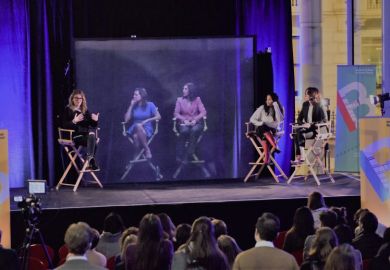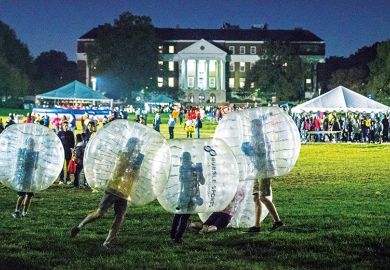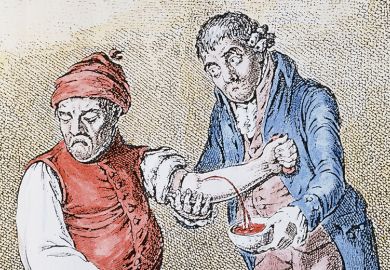With Halloween upon us, a large number of people are taking this seasonal opportunity to go on ghost walks. While guided walks are an increasing part of the fabric of urban tourism in the UK every summer, Halloween offers an additional opportunity to embrace the spooky stories linked to British cities. It also presents a distinct opportunity to take teaching beyond the standard format of the lecture or seminar room and experiment with alternative ways of communicating and engaging with difficult topics.
In our research for “Spectral cities: Death and Living Memories in the Dark Tourism of British Ghost Walks” (in the upcoming November issue of the journal Urbanities) we found that ghost walks enabled guides to discuss the tragic histories of a city in a way that evaded the normal rules of “dark tourism” or “thanatourism” (Seaton 1996).
Across 14 tours based in London, Brighton, York and Edinburgh, we found that violent histories of Roman conquest, Elizabethan persecution of Catholics or deaths of children in Victorian workhouses were recounted in ways that bypassed the normal mournful, sombre and respectful tones of dark tourism.
Whether this took the form of light-hearted re-enactments with participants, the use of magic tricks or carefully crafted “Boo!” moments, the local historians, paranormal experts, actors and professional tour guides who run these walks use every trick in their arsenal to turn stories of real-life tragedies into engaging vignettes as part of a tour through a city’s history.
Grounding the tragedies in the fabric of the urban environment, the tours use humour, shock and grand drama to draw the audience in, and by recounting many deaths they breathe a city to life.
Ghost tours are part of the wider phenomenon of “dark tourism” – where tourists are drawn to a particular place due to its connection with tragic events. Ordinarily the gravity of these events demand mournful respect. Yet ghost walks misbehave and run contrary to this.
Some of this is to do with temporal distance – as is popularly noted, comedy is tragedy plus timing. But this is not quite a sufficient account; ghosts connected with the Second World War were among those encountered, while elsewhere tragedies relating to the war remain bound by the sombre conventions of dark tourism. Instead we find that the presence of ghosts adds an uncanny aspect that facilitates a shift into the realm of entertainment, and allows difficult histories to be diffused as they are recounted as “ghostly tales”.
In the absence of “ghosts” in higher education (although we’re sure many certainly haunt the corridors of some of our oldest institutions) we need to produce the uncanny ourselves if we are to perform the same trick of making resonant connections with our audience when introducing difficult topics that might otherwise demand expected cultural responses – such as seriousness or mournfulness.
We often feel bound by the format of reading/lecture/seminar or by the conventional manner of delivering PowerPoint lectures, yet it is so refreshing when we find ourselves outside that space.
There is a growing body of HE teaching that uses alternative approaches or subversive methods to bypass the ordinary rules for imparting knowledge. Like ghost tours they embrace place, movement and performance to more readily communicate and engage with their audience.
Les Back, professor of sociology at Goldsmiths, University of London, uses “walking tours”, where moving through the city is used to reflect on everything from the 2012 riots in southeast London to the New Cross fire of 1981.
In another direction, impact manager Kieran Fenby-Hulse’s Academic Cabaret demonstrates how we can flip the conventions of academic presentation if we take ourselves a bit less seriously and embrace performance in our communications.
Ghost walks hint at how conventions can be broken in order to actively engage our audience with the world we are trying to show them. They talk of victims of domestic violence, abandoned children in small attic rooms, bigamous marriages and secret relationships to frame cities as sites full of domestic outrage. And they build a sense of urban life that resonates with stereotypes about atomised individuals and decentralised lifestyles.
All this is made possible through the uncanny nature of ghosts – that focuses on the experience of being immersed in the city, or the spectacle of the narrator – a sleight of hand that allows different ways of learning about the past to slip in.
Bereft of our own handy apparitions, we might look instead to produce something uncanny, playing with conventions to push the boundaries of teaching in an attempt to conjure some chicanery of our own.
Gavin Weston and Helen Cornish are lecturers in anthropology at Goldsmiths, University of London. Justin Woodman is a senior lecturer and senior tutor in anthropology at Goldsmiths, and Natalie Djohari is a research associate in the school of international development at the University of East Anglia.
Register to continue
Why register?
- Registration is free and only takes a moment
- Once registered, you can read 3 articles a month
- Sign up for our newsletter
Subscribe
Or subscribe for unlimited access to:
- Unlimited access to news, views, insights & reviews
- Digital editions
- Digital access to THE’s university and college rankings analysis
Already registered or a current subscriber?



